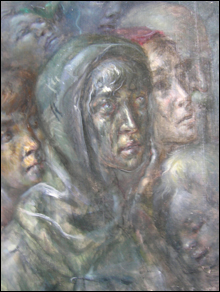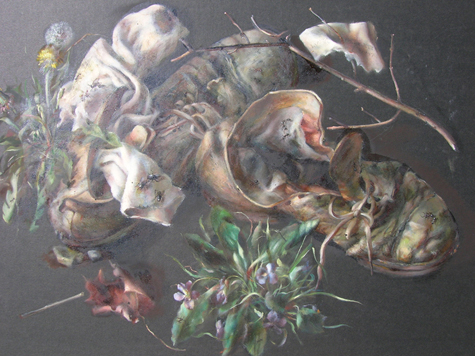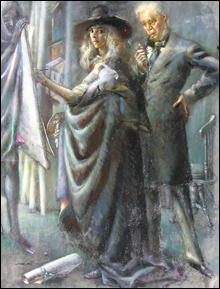
HAUNTED Marianetti's Survivors.
|
The starched woman in Louise Marianetti's 1942 painting holds a copy of the libretto to Verdi's Aida. Her blonde ringlets are decorated with flowers, a pair of blue birds, and a veil. But what sticks with you how she stares with her eerie blue eyes."The Magical Realism of Louise E. Marianetti" at Bert Gallery (540 South Water Street, Providence, through March 19) resurrects the career of the artist who was born in Providence in 1916. She studied at RISD and the New York Art Students League, where she picked up the egg tempera technique of the early Renaissance. Marianetti returned to her family's home in North Providence in the early 1940s and often wore a black beret.
Paintings from the late 1930s and early '40s use bright reds, blues, and golden browns to depict children studying art or at a fair. Another tempera depicts a nude green nymph lounging with the fish at the bottom of the sea.
The high point of Marianetti's career may have been her 1949 exhibits at the Newport Art Museum and Boston's Vose Gallery (the inspiration for the Bert show). By then, her paintings had turned gloomy, prompting the Boston Herald to report that she "seems to be a brooding and mystical creative spirit."
You can detect the influence of the 1930s Social Realists mixed with Surrealist mystery. Marianetti's tempera painting Abandoned Shoes, a detailed still life of decaying shoes amidst scraps of cloth, dandelions, and autumn leaves, can bring to mind Ivan Albright's brooding eccentric paintings of tired people and rotting scenes. But her work here is more modest and the results more uneven than Albright's. It doesn't approach his mordant, rueful, astonishingly obsessive vision.
Bert Gallery owner Cathy Bert says Marianetti may have been moved by the struggles of New York poor that she learned of through Catholic service groups. But I can't help thinking of the aftermath of World War II when I see her 1949 painting Survivors, with a bunch of heads crowded into the picture around a weary, grimy, haunted-eyed woman in a hood and cape who holds a sleeping child to her breast. Marianetti paints the woman's face with lots of short brushstrokes that make it look as if her skin is falling apart.

STILL LIFE Marianetti's Abandoned Shoes.
|
At the Vose show, according to family lore, she met Everett Marshall, a baritone who made his debut at New York's Metropolitan Opera in 1927 and starred in the 1935 Busby Berkeley film I Live for Love. After a decade of courtship, Marshall and Marianetti married in Texas in 1959. After his death in 1963 in California, Marianetti returned to Rhode Island, where she lived until her death in 2009.

SELF-PORTRAIT Detail from At the Opera. |
Marshall may be the white-haired dandy smoking a pipe behind Marianetti's self-portrait in At the Opera, which Bert dates to 1948. Marianetti has long flowing white hair and is dressed in a witchy broad brimmed hat and long cape. She paints upon a board held up by a gaunt, gray figure wrapped up like a mummy. At first it seems like an allegory about the artist, powerful men, and death. But the title's reference to opera suggests that it's a goth performance too.Brian Knep of Cambridge, Massachusetts, is one of the most interesting digital artists in the region, and perhaps the country, because he pays as much attention to the tech (1991 master's in computer science from Brown, a stint developing special effects for the film Jurassic Park) as to meaning.